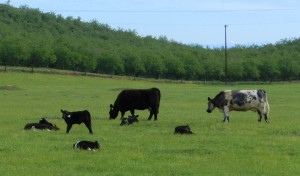
Probably the most common controversy involving numbers and water is about how much water is used by agriculture. There are two camps. One says agriculture uses 80% of the water in California; the other says it uses around 40%. Both figures are usually tossed around absent qualifiers or context.
Here’s a quick and easy explanation of the figures from The Public Policy Institute of California (PPIC):
“More than half of California’s environmental water use occurs in rivers along the state’s north coast. These waters are largely isolated from major agricultural and urban areas and cannot be used for other purposes. In the rest of California where water is shared by all three sectors, environmental use is not dominant (33%, compared to 53% agricultural and 14% urban)…Approximately nine million acres of farmland in California are irrigated, representing roughly 80% of all human water use.”
The 80% figure is applied to human water use and is derived from so-called “developed” water sources—dams, canals, pumping plants, etc. It could also be called, “available water.”
There’s also a lot of finger-pointing about water-consumptive crops, especially almonds. However, we’ve known for a long time that beef production consumes by far the most water of all food-producing sources. According to George Wuerthner, “In 1997, 1.7 million acres of the state were planted to alfalfa alone. Irrigated pasture and hayfields consume more water than any other single crop in California.”
Today, even though almond orchards are replacing irrigated pasture at an unsustainable rate, our craving for steaks and hamburgers is still far harder on the environment than all the almond orchards put together.
Another disputed figure about water centers on agriculture’s contribution to the economy. Here’s the breakdown according to PPIC:
“But even as the agricultural economy is growing, the rest of the economy is growing faster. Today, farm production and food processing only generate about 2% of California’s gross state product, down from about 5% in the early 1960s.”
Seen in the context of the entire state economy, agricultural water use comes into clearer focus. Those who lament lost jobs and dire economic impacts from fallowing farmland seldom mention the impacts on fisheries, industry, small business, tourism, and other interests when water is diverted away from these groups in favor of agriculture.
In the final analysis, using numbers in the Water Game is more like a contest between staves and maces than an effort to deal fairly with California’s water woes. What UC Davis Professor Emeritus Jeffrey Mount calls “combat accounting” provides a diversion from a simple truth no one wants to face: Water in California is over-allocated.
Years ago, when we sent northern California water south, we didn’t account for burgeoning population growth. When we sent northern California south, we never imagined farmers there would plant ever-increasing acres of permanent crops. When we sent northern California water south, we lived in world where snow in the mountains and rain in the winter seemed to provide more water than we needed.
Today, even if the snow and rain return, there won’t be enough water for everyone. Someone’s going to lose. That’s why numbers in the Water Game will most likely continue to serve as weapons instead of information.
